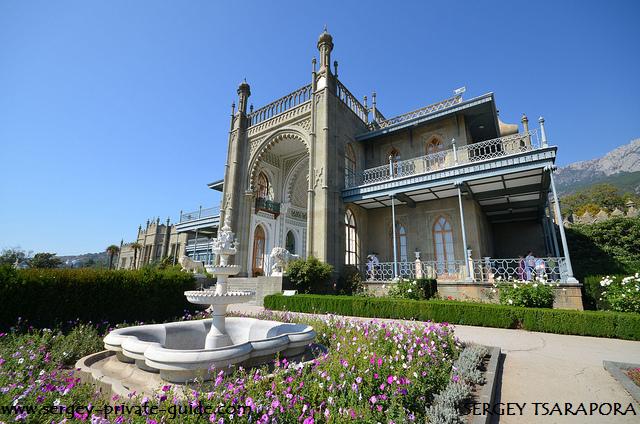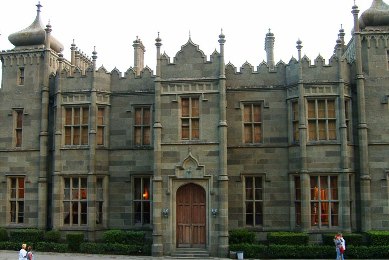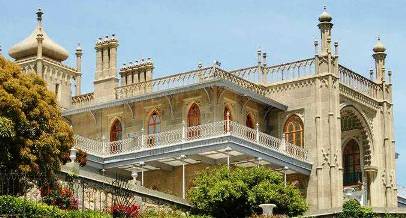The Alupka
Palace-Museum is a unique architectural monument belonging to the first half of
the 19th century. The Palace harmoniously blends with the surrounding landscape. The extended
lines of the facade resemble the mount Ai-Petri contours while
the jagged walls and towers remind one of the picturesque blue and
brown spurs of a huge mountain range.
The construction of the Palace and the adjoining
park cost its former owner Count Mikhail Vorontsov millions of roubles which he
drew from his mercilessly exploited serf peasants.
Magnificent buildings were erected and lavishly decorated by stone-masonsfrom
the Count's estates in Moscow and Vladimir gubernias (provinces), skillfull
joiners and clay-modelers from the town of Moshny in Kiev region and
other craftsmen coming from different parts of Russian Empire. The
work took twenty years, from 1828 to 1848. The serf artisans cut
elegant turrets, merlons, openwork arches and other exterior
decorations out of locally found greenish grey stone of
diabase which was extremely hard to handwork.
The well-known English architect Edward Bloor (1789-1879)
designed the Palace as a combination of massively solid
Gothic castles and gracious Oriental edifices noted for their elaborately
executed architectural details of complicated forms. A resemblance characteristic of medieval castles is
given to the Palace by round asymmetrical turrets with merlon crowns of
the western facade, high walls with window slits, numerous spires and
peculiarly arranged chimneys. Elements of English Gothic style -
covered crossings, a steel footbridge and indented walls -
are also vivid in a narrow passage that separates the Shuvalov Building from
the household premises.
The northern facade contains elements of different
architectural styles. The rectangular towers with tetrahedral domes on the
sides of the central building are distinguished by traces of
Oriental architecture. However, the whole of the facade with its
large bow windows is typical of the 16th-century English architecture.
 The southern facade of the central building is dominated
by a monumental bay-shaped portal with corrugated arches.
The inside of the portal is adorned with rich stuccowork and coffers with a
wide frieze which features an Arabic saying "There is but one
Omnipotent, and his name is Allah" repeated six times. Such
maxims were often used for decorative purposes in Moslem art. It is this combination of complementary
architectural styles which gives the Palace the appearance of an integrally
united whole.
The southern facade of the central building is dominated
by a monumental bay-shaped portal with corrugated arches.
The inside of the portal is adorned with rich stuccowork and coffers with a
wide frieze which features an Arabic saying "There is but one
Omnipotent, and his name is Allah" repeated six times. Such
maxims were often used for decorative purposes in Moslem art. It is this combination of complementary
architectural styles which gives the Palace the appearance of an integrally
united whole.
The exterior of the Palace is inseparable from the
interior decoration of the main rooms which house the Alupka
Museum today. Despite the large number of styles, every single detail
lends peculiar grace to the room. The Entrance Hall,
the Dining Room and the Billiard Room are finished
mostly in dark oak. Wall panels with superimposed Gothic
ornamentation match profiled wooden ceilings that bring to mind stone Gothic
vaults. The walls and the ceiling of the Blue Drawing Room are
embellished with white modelled vegetables on a blue background.
An ingenious design is found in the Chinese Study:
its high oak wall panels are covered with a carved fretwork in
the Italian Renaissance style with some Gothic elements apparently
incorporated. Chinese straw mats on the walls are
embroidered with flower and cornucopia patterns made of silk and
bugles. The room's molded ceiling is painted in
imitation wood and ornamented with alabaster vegetables.
The walls of the Chintz Room are upholstered with
printed cotton fabric from France while the Main Study and the
Entrance Hall are wallpapered. Two
Deautitul carpets catch one's eye in the small waiting room of the
Entrance Hall. Woven by Aga Bozorh, mastercraftsman from the
Persian town of Resht, the appliqued carpets are ornate with embroidery. Of particular interest are fireplaces in the main rooms.
They, as well as the lintels and mantelpieces, are often peculiarly
shaped and decorated with various types of stone.
 The Palace has a rich collection of luxurious, furrnture
made by Russian and West European craftsmen trom
different schools in the late 18th and early 19th
centuries. The cabinet-makers exploit ed valuable species
of timber, inlaying the pieces with metal, tortoise-shell, nacre and
ivory decorations. In the Main Study, visitors' attention is always attracted
by a black wooden bookcase with metal and tortoise-shell inlay. The
case is typical of the Boulle style, named so after the
Frenchmaster of the early 18th century who developed an
exquisite technique ot inlay work and obtained remarkable
colouristic effects. Late Russian Classicism is represented, in particular, by
the Blue Drawing Room suite made in the 20s-30s of the 19th century:
white pieces with gilded insertions are adorned with
ornamental patterns in the form of palm leaves, wheat
spikes and vines.
The Palace has a rich collection of luxurious, furrnture
made by Russian and West European craftsmen trom
different schools in the late 18th and early 19th
centuries. The cabinet-makers exploit ed valuable species
of timber, inlaying the pieces with metal, tortoise-shell, nacre and
ivory decorations. In the Main Study, visitors' attention is always attracted
by a black wooden bookcase with metal and tortoise-shell inlay. The
case is typical of the Boulle style, named so after the
Frenchmaster of the early 18th century who developed an
exquisite technique ot inlay work and obtained remarkable
colouristic effects. Late Russian Classicism is represented, in particular, by
the Blue Drawing Room suite made in the 20s-30s of the 19th century:
white pieces with gilded insertions are adorned with
ornamental patterns in the form of palm leaves, wheat
spikes and vines.
The furniture in the main rooms is appropriately matched
by numerous articles of applied art – crystal chandeliers, wall
lamps, candelabra, vases, clocks, statuettes, etc.
Canvases, particularly by Dutch, Flemish,
Italian and French artists of the 16th - 18th centuries, were a
customary vogue in the palaces of the time. Presently the Museum exhibits
paintings by C. Netscher, P. Sneyers, W. Hogarth, F. Pourbus, C. Maratti, H.
Robert, to mention but a few. In the halls of the Palace-Museum there is an
exhibition of Russian and Ukrainian paintings of the 18th - early
20th centuries: portraits by V. Borovikovsky, D. Levitsky, I.
Kramskoi, O. Murashko, genre paintings by K. Trutovsky, G. Myasoyedov, N.
Kasatkin, M. Pimonenko, seascapes by I. Aivazovsky,
landscapes by S. Vasilkivsky, I. Levitan and others.
The Alupka Museum picture collection also includes
canvases by Soviet artists M. Bozhiy, Yo. Bokshai, V. Byalinitsky-Birulya, S.
Gerasimov, I. Grabar, A. Kuprin, N. Romadin and others. These and other
paintings are exhibited in the central building and
the Shuvalov Building.
A narrow corridor and a flight of wide stairs bring
one from the central building to the Library Building. At present
the library stock contains a part of Count Vorontsov's book
collection and a wide selection of periodicals of the late
19th - early 20th centuries. The Library Building is directly above the
Exhibition Hall where Soviet artists put
their works on display regularly.
A winter garden was built as a traditional sup
plement to the Palace. Today, as well as a century and
a half ago, exotic trees and plants grow here around white marble
sculptures. One will see copies of the ancient statues of Apollo
Belvedere, Bathing Aphrodite and Urania, the Greek Muse of
astronomy; also the original "Little Girl" by the Italian Sculptor
Quintilliano Corbellini, "First Steps" by Laurent-Honore
Marqueste and others.
 A picturesque park with the total area close
to 100 acres surrounds" the Palace. It abounds in both local
species of trees and shrubs and exotic plants which came mainly
from Mediterranean region, and also from Western Asia. China and the
American subtropics. The park was laid out by serf peasants under
the supervision of the German gardener K. Kebach. The
magnificent Upper Park, planned in the English landscape style,
fascinates the eye with its spacious
green glades, where pines, cypresses and mighty cedars
grow as if on a wood's edge. Its clear ponds where swans and
decorative fish swim, mysterious grottoes with huge diabase
cliffs beetling above, small but extremely picturesque waterfalls
are a paradise on earth. The so-called Great Chaos, a
natural agglomeration of massive rocks, can be found in the northern
end of the Upper Park.
A picturesque park with the total area close
to 100 acres surrounds" the Palace. It abounds in both local
species of trees and shrubs and exotic plants which came mainly
from Mediterranean region, and also from Western Asia. China and the
American subtropics. The park was laid out by serf peasants under
the supervision of the German gardener K. Kebach. The
magnificent Upper Park, planned in the English landscape style,
fascinates the eye with its spacious
green glades, where pines, cypresses and mighty cedars
grow as if on a wood's edge. Its clear ponds where swans and
decorative fish swim, mysterious grottoes with huge diabase
cliffs beetling above, small but extremely picturesque waterfalls
are a paradise on earth. The so-called Great Chaos, a
natural agglomeration of massive rocks, can be found in the northern
end of the Upper Park.
Laid out as a regular Italian park, the Lower Park
stretches from the Palace downwards to the Black Sea coast. A
pavilion with Doric columns is situated on one of tne terraces ot
the Lower Park - this is the Tea House, built in the early 30s of
the 19th century. Another wide terrace which adjoins the Palace
from the south has stone parapets with vases on them and Oriental cup-shaped fountains.
A wide stone stairway leads to the main entrance to the
Palace. On both sides of the stairs there are six lion
figures made or white marble. The Sleeping Lion by the Italian sculptor Bonanni is
the most perfect or an the sculptures in execution. The sculptor's pupils cut
the other rive figures of the awakening and vigilant lions.
